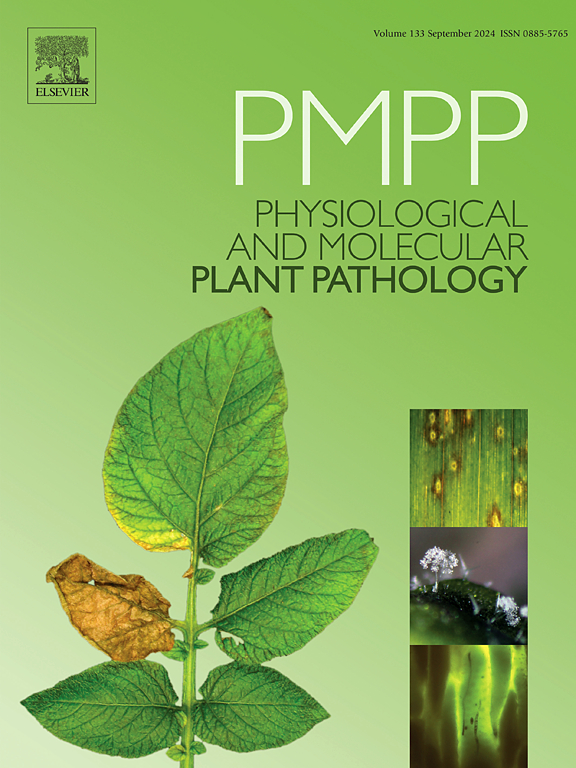Bhendi yellow vein mosaic virus infection alters Extrachromosomal circular DNA profiles and may contribute to the current understanding of begomoviral genome dynamics and disease complexity
IF 2.8
3区 农林科学
Q2 PLANT SCIENCES
引用次数: 0
Abstract
Extrachromosomal circular DNA (eccDNA) is chromosomal byproducts that influence genome dynamics. While their biogenesis in plants remains only partially understood, factors such as stress and adaptation appear to modulate their abundance. We hypothesize that viral infections impose physiological stress, triggering genomic responses—including altered gene expression, epigenetic modifications, and structural variations—that may promote eccDNA formation. Viral proteins such as Rep, AC2/C2, AC4/C4, and chromatin-modulating proteins with DNase activity may contribute to this process. In this study, we investigated virus-induced eccDNA in Nicotiana benthamiana plants infiltrated with infectious clones of Bhendi yellow vein mosaic virus (BYVMV). DNA was isolated from both wild-type and symptomatic plants, enriched for eccDNA, and subjected to rolling circle amplification (RCA), next-generation sequencing (NGS), and analysis through a custom bioinformatics pipeline designed to exclude genomic, organellar, and viral DNA. Our analysis revealed virus-induced eccDNAs carrying host genes that may support viral infection, suggesting that the virus may manipulate host genome architecture. Interestingly, several eccDNA candidates from BYVMV-infected samples harbored the geminiviral nonanucleotide sequence, implicating its potential role in disease progression and enhanced viral acquisition. These findings provide novel insights into plant-virus interactions, highlighting the dual role of eccDNA in host defense and viral manipulation, and laying the foundation for future studies into eccDNA's role in plant stress responses and adaptive mechanisms.
bendi黄静脉花叶病毒感染改变染色体外环状DNA谱,可能有助于当前对begomovirus基因组动力学和疾病复杂性的理解
染色体外环状DNA (eccDNA)是影响基因组动力学的染色体副产物。虽然它们在植物中的生物起源尚不完全清楚,但压力和适应等因素似乎调节了它们的丰度。我们假设病毒感染施加生理压力,引发基因组反应,包括基因表达改变、表观遗传修饰和结构变异,这可能促进ecdna的形成。病毒蛋白如Rep、AC2/C2、AC4/C4和具有dna酶活性的染色质调节蛋白可能参与了这一过程。在本研究中,我们研究了感染bendi黄脉花叶病毒(BYVMV)克隆的本烟(Nicotiana benthamiana)植物中病毒诱导的eccDNA。从野生型和症状型植物中分离DNA,富集eccDNA,进行滚圈扩增(RCA)、下一代测序(NGS),并通过定制的生物信息学管道进行分析,该管道旨在排除基因组、细胞器和病毒DNA。我们的分析显示,病毒诱导的携带宿主基因的eccdna可能支持病毒感染,这表明病毒可能操纵宿主基因组结构。有趣的是,来自byvmv感染样本的几个eccDNA候选物含有双病毒非核苷酸序列,暗示其在疾病进展和增强病毒获取中的潜在作用。这些发现为植物与病毒的相互作用提供了新的见解,突出了eccDNA在宿主防御和病毒操纵中的双重作用,为进一步研究eccDNA在植物逆境反应中的作用和适应机制奠定了基础。
本文章由计算机程序翻译,如有差异,请以英文原文为准。
求助全文
约1分钟内获得全文
求助全文
来源期刊
CiteScore
4.30
自引率
7.40%
发文量
130
审稿时长
38 days
期刊介绍:
Physiological and Molecular Plant Pathology provides an International forum for original research papers, reviews, and commentaries on all aspects of the molecular biology, biochemistry, physiology, histology and cytology, genetics and evolution of plant-microbe interactions.
Papers on all kinds of infective pathogen, including viruses, prokaryotes, fungi, and nematodes, as well as mutualistic organisms such as Rhizobium and mycorrhyzal fungi, are acceptable as long as they have a bearing on the interaction between pathogen and plant.

 求助内容:
求助内容: 应助结果提醒方式:
应助结果提醒方式:


